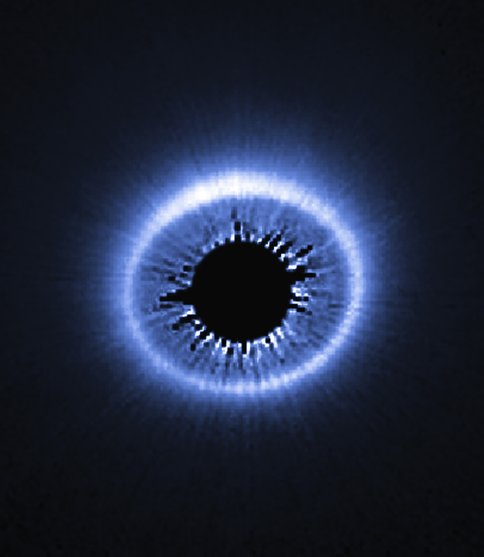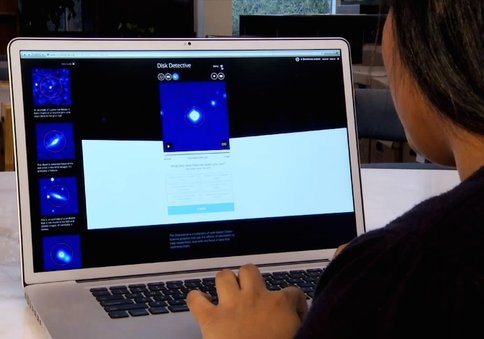2014 Annual Science Report
 NASA Goddard Space Flight Center
Reporting | SEP 2013 – DEC 2014
NASA Goddard Space Flight Center
Reporting | SEP 2013 – DEC 2014
Circumstellar Debris and Planetesimals in Exoplanetary Systems
Project Summary
This year, GCA astronomer Marc Kuchner invited the public to help him discover new planetary systems through a new website, DiskDetective.org. At DiskDetective.org, volunteers view data from NASA’s Wide-field Infrared Survey Explorer (WISE) mission and three other surveys. WISE measured more than 745 million objects, representing the most comprehensive survey of the sky at mid-infrared wavelengths ever taken.
Project Progress
This year, GCA astronomer Marc Kuchner invited the public to help him discover new planetary systems through a new website, DiskDetective.org. At DiskDetective.org, volunteers view data from NASA’s Wide-field Infrared Survey Explorer (WISE) mission and three other surveys. WISE measured more than 745 million objects, representing the most comprehensive survey of the sky at mid-infrared wavelengths ever taken. Among these objects are thousands of planetary systems, recognizable by the dusty disks that surround them, waiting to be discovered. But galaxies, interstellar dust clouds and asteroids also glow in infrared, which stymies automated efforts to identify these disks. The volunteers at Disk Detective.org find the disks by watching 10-second videos of objects seen by WISE, and classifying them by clicking on a selection of buttons on their screens (Fig. 1).
In less than a year, citizen scientists using DiskDetective.org logged 1 million classifications of potential debris disks and disks surrounding young stellar objects (YSO disks). Volunteers even made their own tutorial videos for the project and translated the website into ten different languages. This work has yielded so far 658 objects of interest, of which 240 have been reobserved with ground-based telescopes in Arizona, New Mexico, California, and Argentina. The best of these disk candidates, in turn, will become targets for larger ground-based telescopes, and, down the line, Hubble and/or JWST. Images of these disks made by larger telescopes often reveal beautiful patterns like this spectacular image of HD 181327 above, a ring likely sculpted by an extrasolar planet (Fig. 2). The Disk Detective science team hopes to complete the project by 2018, when JWST launches.
Kuchner also reached an important milestone in his work on debris disks dynamics. He and student Erika Nesvold applied their 3D debris disk model, SMACK, to simulate a planet on a circular orbit near a ring of planetesimals that are experiencing destructive collisions. Previous simulations of a planet opening a gap in a collisionless debris disk have found that the width of the gap scales as the planet mass to the 2/7th power (alpha = 2/7). They found that gap sizes in a collisional disk still obey a power law scaling with planet mass, but that the index (alpha) of the power law depends on the age of the system relative to the collisional timescale t coll of the disk, according to alpha = 0.32(t/t coll)-0.04, with inferred planet masses up to five times smaller than those predicted by the classical gap law. The increased gap sizes likely stem from the interaction between collisions and the mean motion resonances near the chaotic zone.
Publications
-
Chen, C. H., Mittal, T., Kuchner, M., Forrest, W. J., Lisse, C. M., Manoj, P., … Watson, D. M. (2014). THE SPITZER INFRARED SPECTROGRAPH DEBRIS DISK CATALOG. I. CONTINUUM ANALYSIS OF UNRESOLVED TARGETS. The Astrophysical Journal Supplement Series, 211(2), 25. doi:10.1088/0067-0049/211/2/25
-
Currie, T., Burrows, A., Girard, J. H., Cloutier, R., Fukagawa, M., Sorahana, S., … Pyo, T-S. (2014). DEEP THERMAL INFRARED IMAGING OF HR 8799 bcde: NEW ATMOSPHERIC CONSTRAINTS AND LIMITS ON A FIFTH PLANET. The Astrophysical Journal, 795(2), 133. doi:10.1088/0004-637x/795/2/133
-
Mennesson, B., Millan-Gabet, R., Serabyn, E., Colavita, M. M., Absil, O., Bryden, G., … Woillez, J. (2014). CONSTRAINING THE EXOZODIACAL LUMINOSITY FUNCTION OF MAIN-SEQUENCE STARS: COMPLETE RESULTS FROM THE KECK NULLER MID-INFRARED SURVEYS. The Astrophysical Journal, 797(2), 119. doi:10.1088/0004-637x/797/2/119
-
Nielsen, E. L., Liu, M. C., Wahhaj, Z., Biller, B. A., Hayward, T. L., Males, J. R., … Toomey, D. W. (2014). THE GEMINI NICI PLANET-FINDING CAMPAIGN: THE ORBIT OF THE YOUNG EXOPLANET β PICTORIS b. The Astrophysical Journal, 794(2), 158. doi:10.1088/0004-637x/794/2/158
-
Schneider, G., Grady, C. A., Hines, D. C., Stark, C. C., Debes, J. H., Carson, J., … Rodigas, T. J. (2014). PROBING FOR EXOPLANETS HIDING IN DUSTY DEBRIS DISKS: DISK IMAGING, CHARACTERIZATION, AND EXPLORATION WITH HST /STIS MULTI-ROLL CORONAGRAPHY. The Astronomical Journal, 148(4), 59. doi:10.1088/0004-6256/148/4/59
-
Stark, C. C., Schneider, G., Weinberger, A. J., Debes, J. H., Grady, C. A., Jang-Condell, H., & Kuchner, M. J. (2014). REVEALING ASYMMETRIES IN THE HD 181327 DEBRIS DISK: A RECENT MASSIVE COLLISION OR INTERSTELLAR MEDIUM WARPING. The Astrophysical Journal, 789(1), 58. doi:10.1088/0004-637x/789/1/58
-
Wahhaj, Z., Liu, M. C., Biller, B. A., Nielsen, E. L., Hayward, T. L., Kuchner, M., … Toomey, D. W. (2014). The Gemini NICI planet-finding campaign: The offset ring of HR 4796 A. A&A, 567, A34. doi:10.1051/0004-6361/201323335
-
PROJECT INVESTIGATORS:
-
PROJECT MEMBERS:
Marc Kuchner
Project Investigator
-
RELATED OBJECTIVES:
Objective 1.1
Formation and evolution of habitable planets.
Objective 1.2
Indirect and direct astronomical observations of extrasolar habitable planets.
Objective 3.1
Sources of prebiotic materials and catalysts

